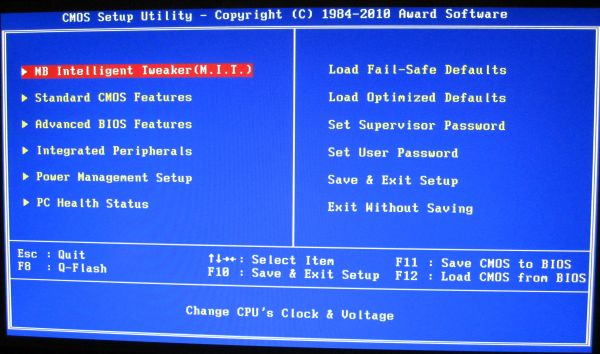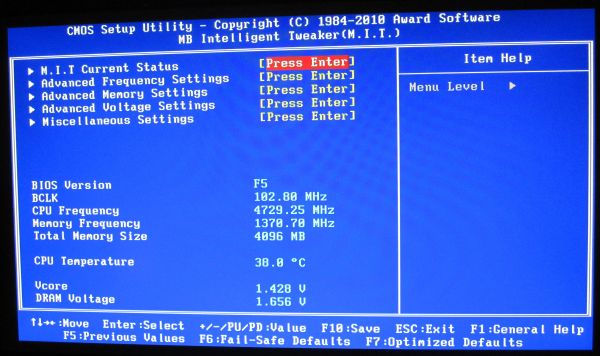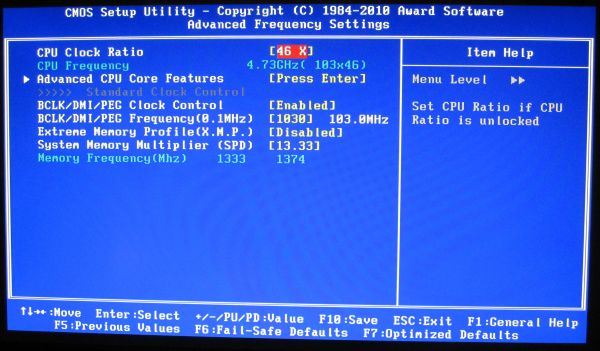The Battle of the P67 Boards - ASUS vs. Gigabyte at $190
by Ian Cutress on January 20, 2011 4:15 PM EST- Posted in
- Motherboards
- Gigabyte
- Asus
- P67
BIOS
Gigabyte has not been on the ball BIOS/UEFI wise for Sandy Bridge. In the Visual Inspection, I explained at how the board is actually 64-bit UEFI but with a BIOS interface attached (for stability, after years of working at it) with plans to possibly upgrade to a GUI at a later date. Though in the name of stability, the launch BIOS has significant issues with turbo boosting, where only a 1x multiplier boost gets applied at any thread loading, rather than 4x/3x/2x. It wasn't as simple as downloading the latest BIOS from the website and updating - in order to get it to work properly, I had to load in an OS, and download the latest version of @BIOS, their BIOS updating tool, and grab the latest BIOS. You cannot use the version of @BIOS on the CD, you need the latest version, and you cannot use QFlash in the BIOS, as they both do not recognise any BIOS F6 or above as valid. I downloaded the latest BIOS file from the website, and use @BIOS to update from the file. At the time of writing, the F7b BIOS is the latest, which implements turbo modes correctly.
If you have worked with a BIOS before, Gigabyte is not throwing up too many new features to surprise you – only those based around Sandy Bridge. Everything overclocking, CPU and voltage related is found in the Intelligent Tweaker menu, whereas boot order can be found in the advanced BIOS options.
The Intelligent Tweaker menu gives a quick overview of BCLK, frequency, temperature, voltages, etc. By dividing the all the OC options into the ‘frequency’, ‘memory’, and ‘voltage’ sub-menus, while this splits up the options to make them easier to digest, it does result in more navigation. Personally, I would prefer being able to adjust the CPU/DRAM voltages in the frequency settings as well as the voltage settings.
Thankfully, most of the settings can be adjusted by typing in a value, or by the +/- buttons, or by pressing enter to type/bring a scrollable menu up. I like being able to do this in a BIOS/UEFI, and most manufacturers will leave out at least one of the available ways to change a setting in every sub-menu, or mix and match as they deem appropriate.
The BIOS allows eight profiles to be saved on board, or you can save/load to a file. Given some of the overclocking problems I mention below, every time a re-flash of the BIOS was required, all my saved on board settings were lost.
Overclocking
Overclocking on the P67-UD4 was almost as easy as it has been on previous BIOS boards, although there was no easy overclock presets available in the BIOS. EasyTune6, the OS software on the Gigabyte CD, gives automatic options for 35x, 37x and 40x multiplier at 100 MHz bus speed. These settings, as in previous Gigabyte iterations and boards, work pretty well, but a 4 GHz overclock on Sandy Bridge is not going to win any awards.
Going into the BIOS, I immediately left everything on auto and upped the multiplier to 45x, for a 4.5 GHz processor speed. This successfully booted into Windows, passed the stability tests, then BSOD on shutdown. On the restart, the board attempted to boot back at stock, which was disappointing.
As with previous overclocking attempts, I jumped in and put the VCore straight at 1.42V, with a 1.9V PLL. Upping the multiplier to 45x to give 4.5 GHz this time was no trouble. 4.6 GHz and 4.7 GHz also passed without issue. 4.8 GHz booted into the OS, but failed the OCCT stress test, so I rolled back the multiplier to 47x and started playing with the BCLK by 1 MHz at a time. 101 MHz also failed the stress test, leaving 47 * 100 MHz as a good overclock. This board automatically puts a -0.2 MHz bias on the BCLK, meaning that the speed is actually 47 * 99.8 MHz = 4.69 GHz.
Out of interest, I rolled back the multiplier again to 46x and upped the BCLK this way. With a 102.2 MHz BCLK, it would beat the speed of the 47 * 100 MHz overclock, so I booted at 102.5 MHz (102.3 MHz effective), with a 46x multiplier, which passed. 103 MHz did not however, so 102.5 MHz * 46 (102.3 MHz * 46 effective = 4706 MHz) would seem the best option, as it contains that small little BCLK boost to help other components and memory.
With the board’s Dual BIOS system, on a severe failed boot type unsuccessful overclock by increasing the multiplier too much, the board would revert to the backup BIOS, and then boot me straight into the BIOS. If I changed anything, it would load the standard BIOS again with my new settings. Also of note, if I upped the BCLK too far, the system would restart in one of two ways – without any overclock at all, or at 100 MHz with my chosen multiplier. If I increased the RAM too far, it would keep rebooting and never getting to the POST screen until I used a jumper on the Clear CMOS header. Note, no jumpers are included in the box, so you have to find your own way of shorting those pins. I also tried going for 50x multiplier, 100 MHz BCLK, at 1.50 V. On a failed boot into Windows, the main BIOS became corrupted and had to be restored by the backup – then I had to load into the OS to run @BIOS to update to the F7b BIOS again, because the backup BIOS is F1 and doesn’t recognise the F7b BIOS file as a valid BIOS, which was frustrating.
At 4.706 GHz (42.6% OC over 3.3 GHz/non turbo/multithreaded, 27% OC over 3.7 GHz/turbo/single-threaded), the 3D Movement benchmark was run. In single thread mode, a score of 145.19 was achieved, a 28% increase. In multi-threaded mode, a score of 463.12 was achieved, a 38.6% increase.



















137 Comments
View All Comments
kmmatney - Monday, January 24, 2011 - link
Agreed. The last 3 motherboards I bought all came free (or close to it) in a Microcenter deal. 2 AMD system, and one Intel (socket 775). They all have decent overclocking, and have been plenty stable. Your better off spending the money you save on more RAM, or an SSD.MobiusStrip - Sunday, January 23, 2011 - link
"I'ma get that"You left out the wrong word. The "a" is the beginning of "a-gonna"; the phrase is "I'm a-gonna" do something. If you're going to remove something, it's the "a": I'm gonna get that.
softdrinkviking - Monday, January 24, 2011 - link
For all you know, "I'ma get that" could be widely used in this person's area, how would you know?Don't correct slang, it completely defeats the purpose, and it's kind of insane.
Sufo - Tuesday, January 25, 2011 - link
The "a" is the last a of gonna. The part that is omitted is the "gonn". If you're going to be such a useless pedant, at least get your facts straight.Not the best source, but http://en.wiktionary.org/wiki/Imma
"nope"
maxnix - Thursday, April 28, 2011 - link
Unfortunately for you, spell checking isn't one of them!Spazweasel - Thursday, January 20, 2011 - link
EVGA seems late to the game. They've announced their first 1155 board (130-SB-E675-KR) on their website, but has anyone actually seen it in the wild (much less reviewed)?seamusmc - Friday, January 21, 2011 - link
Spaz, (chuckle)I thought I read somewhere in their forums that EVGA's first P67 board will be available in February.
Spazweasel - Monday, January 31, 2011 - link
http://www.anandtech.com/show/4142/intel-discovers...Okay, now we know why!
It will be interesting to see if EVGA was among the first to be saying "Hey, something's not right here" and this was the reason.
DanNeely - Thursday, January 20, 2011 - link
The obvious feature gigabytes $260/320 board shas is PCIe bridge chips that allow a huge number of USB3 ports and more x16 slots, although you're only getting higher burst performance per device since they're all still sharing the same 16 lanes from the CPU.The other traditional feature is better mofsets/mofset coolers to allow higher voltages for overclocks if you have the cooling to handle the heat.
Pjmcnally - Thursday, January 20, 2011 - link
This is a great review that I was very happy to read. I picked up the ASRock board at release but I wasn’t sure I had made a good decision.I believe there is one small error in the review, the headers for both lists of board features read “ASRock P67 Extreme4” not “Asus P8P676 Pro” or “Gigabyte P67A-UD4”.